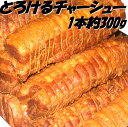I decided to make char siu for the first time in a long time. Although it's called char siu, it's just pork that's been grilled and simmered in soy sauce, which is a different method from the original meaning of char siu, but in Japan, this is also generally considered char siu.
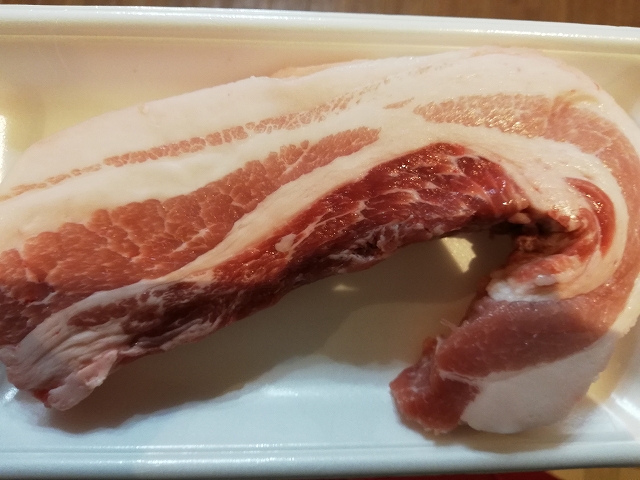
I bought a block of pork belly. I think it was about 800 yen at the local supermarket. Pork belly is ideal for making char siu in a feather pot. Pork belly has a good balance of fat and red meat, and has a moderate chewiness and rich flavor. The pork belly I got this time was too big, so I cut it in half and grilled it slowly in a frying pan.

Grill it in a frying pan until it's well browned.
This time, I'm using a feather pot instead of a regular pot. The feather pot has high heat conductivity, so the heat is evenly distributed, and the inside of the food is evenly heated. This brings out a unique softness and juiciness in the char siu.

When it's browned to about this extent, put it in the feather pot, add soy sauce and water. It's probably best to have a little more than enough to cover the block of meat. The ratio of soy sauce to water is about 2:1. Cover with a piece of aluminum foil that has been crumpled up and spread out as a drop lid. I think a heat level slightly lower than medium is good. Simmer it like this for about 1 to 2 hours.

The ratio of soy sauce to water is about 2:1. In other words, there's more soy sauce. The ratio can be adjusted to taste.A drop lid is essential.
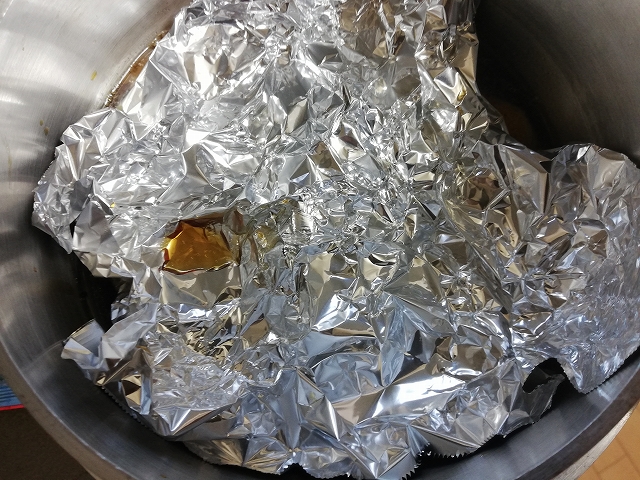
It's done in about an hour to an hour and a half. Cool this a little in the refrigerator.
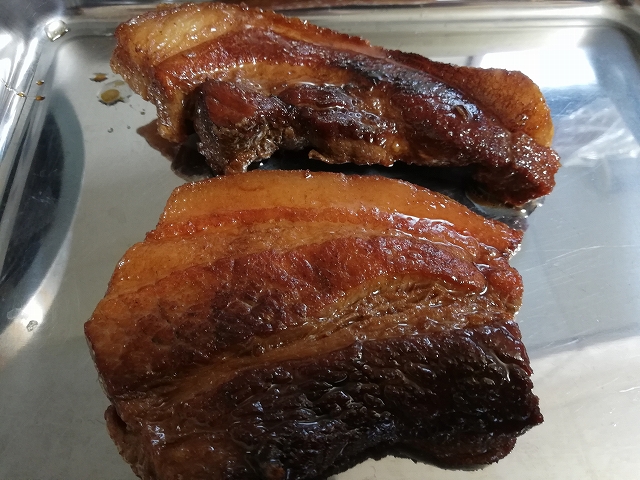
Let it cool in the pot for a while, and when it's cooled down a bit, chill it in the refrigerator. The reason for chilling it in the refrigerator is to make it easier to cut the char siu thinly with a knife. If you don't need to cut it thinly or if you want to eat it right away, you don't need to cool it. The finished char siu looks like this. The flavor is strong, making it just right as a side dish or topping for ramen.
I forgot to write, but keep the sauce that you simmered the char siu in in the refrigerator. It can be used as a seasoning for fried rice and simmered dishes, or as a sauce for ramen.
It's a bit strong in flavor, making it a good topping for ramen or a side dish for sake.
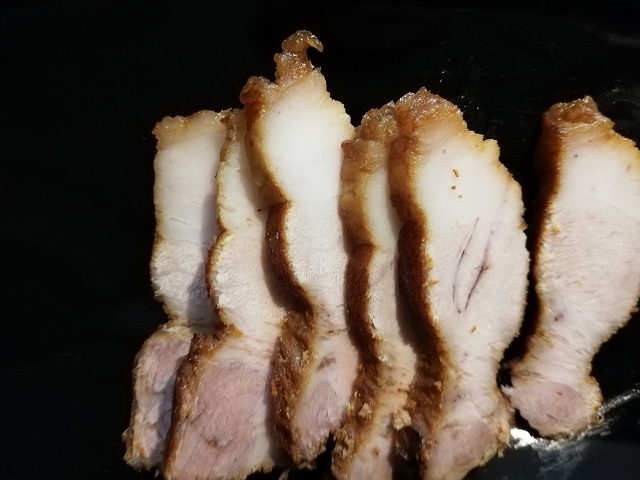
It's quite delicious even though it's very easy to make. I hope campers on the terrace or veranda will give it a try. Of course, it can also be made in a regular kitchen.
Now, let's pick up some important Japanese words and provide detailed explanations in English:
休日 (Kyūjitsu): This translates to "holiday" or "day off" in English. It refers to a day when one is exempt from work, often in observance of a public holiday, a religious holiday, or a personal day.
庭 (Niwa): This translates to "garden" in English. It refers to an outdoor area where plants and flowers are grown. In Japan, traditional gardens often incorporate elements such as ponds, rocks, and tea houses.
テラス (Terasu): This translates to "terrace" in English. It refers to an outdoor space that is usually attached to a house or an apartment. It can be used for various activities such as dining, gardening, or relaxing.
キャンプ (Kyanpu): This translates to "camp" in English. It refers to an outdoor activity involving overnight stays away from home in a shelter such as a tent or a recreational vehicle.
羽釜 (Hagama): This translates to "feather pot" in English. It's a traditional Japanese pot used for cooking rice. It's known for its high heat conductivity, which allows for even heating and cooking.
チャーシュー (Chāshū): This is a term borrowed from Chinese cuisine, referring to a dish where pork belly or pork loin is marinated in a mixture of soy sauce, sugar, and other ingredients, then roasted or braised until tender. In Japan, it's often used as a topping for ramen.
豚バラ肉 (Buta baraniku): This translates to "pork belly" in English. It's a cut of meat from the belly of a pig, known for its rich flavor and tender texture when cooked properly.
醤油 (Shōyu): This translates to "soy sauce" in English. It's a liquid condiment of Chinese origin, made from a fermented paste of soybeans, roasted grain, brine, and Aspergillus oryzae or Aspergillus sojae molds.
ラーメン (Rāmen): This is a Japanese adaptation of Chinese wheat noodles. It's served in a meat or fish-based broth, often flavored with soy sauce or miso, and uses toppings such as sliced pork, nori, menma, and scallions.
落し蓋 (Otoshifuta): This translates to "drop lid" in English. It's a type of lid that's smaller than the pot and sits directly on the food being cooked, promoting even heating and preventing the food from breaking apart during cooking.
冷蔵庫 (Reizōko): This translates to "
冷蔵庫 (Reizōko): This translates to "refrigerator" in English. It's a common household appliance that uses a thermally insulated compartment and a heat pump to transfer heat from its inside to its external environment, cooling the inside below the room temperature to preserve perishable foods.
鍋 (Nabe): This translates to "pot" in English. It's a deep cooking vessel with a handle and lid, used for boiling, stewing, and making soups in Japanese cuisine.
焦げ目 (Kogeme): This translates to "browning" or "sear" in English. It refers to the process of browning the surface of food at high temperatures, which enhances its flavor and appearance.
火加減 (Hikagen): This translates to "heat control" or "flame adjustment" in English. It refers to the adjustment of the heat level when cooking, which is crucial for achieving the desired cooking results.
酒の肴 (Sake no sakana): This translates to "sake accompaniment" or "snack for sake" in English. It refers to food that is typically served with sake, a traditional Japanese rice wine.
キッチン (Kitchin): This translates to "kitchen" in English. It's a room or part of a room used for cooking and food preparation.
ブログ (Burogu): This translates to "blog" in English. It's a discussion or informational website published on the World Wide Web consisting of discrete, often informal diary-style text entries (posts).
ラーメン屋 (Rāmen-ya): This translates to "ramen shop" in English. It's a type of restaurant that specializes in ramen dishes, a popular type of noodle soup in Japan.
ブロック肉 (Burokku niku): This translates to "block meat" in English. It refers to a large piece of meat that is usually cut into smaller pieces for cooking.
豚バラ肉 (Butabara-niku): This translates to "pork belly" in English. It's a boneless cut of fatty meat from the belly of a pig. Pork belly is particularly popular in Japanese cuisine, where it's used in dishes like ramen and yakiniku.
フライパン (Furaipan): This translates to "frying pan" in English. It's a flat-bottomed pan used for frying, searing, and browning foods. It's an essential piece of cookware in many types of cooking.
熱伝導性 (Netsudendō-sei): This translates to "thermal conductivity" in English. It's a physical property of a material that describes its ability to conduct heat. In the context of cookware, materials with high thermal conductivity, like copper, provide quick and even heating.
食材 (Shokuzai): This translates to "ingredients" in English. It refers to the food items or components that are used in the preparation of a dish or meal.
醤油 (Shōyu): This translates to "soy sauce" in English. It's a liquid condiment of Chinese origin, made from a fermented paste of soybeans, roasted grain, brine, and Aspergillus oryzae or Aspergillus sojae molds. Soy sauce is widely used in East and Southeast Asian cuisines.
アルミホイル (Arumihoiru): This translates to "aluminum foil" in English. It's a thin sheet of aluminum that can be used in cooking to cover, wrap, or line pans or trays. It's also used to trap heat in cooking, and to preserve food in the refrigerator.
落し蓋 (Otoshibuta): This translates to "drop-lid" in English. It's a type of lid that's smaller than the pot and sits directly on top of the food being cooked. It's commonly used in Japanese cooking for simmered dishes.
チャーハン (Chāhan): This translates to "fried rice" in English. It's a dish of cooked rice that has been stir-fried in a wok or a frying pan and is usually mixed with other ingredients such as eggs, vegetables, and meat.
ラーメン (Rāmen): This translates to "ramen" in English. It's a Japanese dish with Chinese origins, which consists of wheat noodles served in a meat or fish-based broth, often flavored with soy sauce or miso, and uses toppings such as sliced pork, dried seaweed, and green onions.
トッピング (Toppingu): This translates to "topping" in English. It refers to the extra food that is added on top of the main part of the meal, such as cheese on pizza, or whipped cream on a dessert.
美味しい (Oishii): This translates to "delicious" or "tasty" in English. It's a common adjective used to describe food that has a very pleasant taste.
テラス (Terasu): This translates to "terrace" in English. It's an outdoor living space that's usually paved and adjoins a residence. In the context of the text, it's a place where one can enjoy outdoor activities like camping.
ベランダ (Beranda): This translates to "balcony" or "veranda" in English. It's an outdoor platform that is attached to a house or an apartment, usually enclosed by a railing.
キャンパー (Kyanpā): This translates to "camper" in English. In the context of the text, it refers to a person who enjoys outdoor activities like camping.
キッチン (Kitchin): This translates to "kitchen" in English. It's a room or part of a room used for cooking and food preparation.
ブログ (Burogu): This translates to "blog" in English. It's a discussion or informational website published on the World Wide Web consisting of discrete, often informal diary-style text entries (posts).
ラーメン屋 (Rāmen-ya): This translates to "ramen shop" in English. It's a type of restaurant that specializes in ramen dishes, a popular type of noodle soup in Japan.
ブロック肉 (Burokku niku): This translates to "block meat" in English. It refers to a large piece of meat that is usually cut into smaller pieces for cooking.
豚バラ肉 (Butabara-niku): This translates to "pork belly" in English. It's a boneless cut of fatty meat from the belly of a pig. Pork belly is particularly popular in Japanese cuisine, where it's used in dishes like ramen and yakiniku.
フライパン (Furaipan): This translates to "frying pan" in English. It's a flat-bottomed pan used for frying, searing, and browning foods. It's an essential piece of cookware in many types of cooking.
重要単語
Holiday (ホリデー): [名詞] 休日、祝日。一般的には仕事や学校から自由になる日を指す。
Enjoy (エンジョイ): [動詞] 楽しむ、享受する。何かを心から楽しむことを表す。
Garden (ガーデン): [名詞] 庭。家の外にある土地の部分で、植物が植えられ、人々がリラックスできる場所。
Terrace (テラス): [名詞] テラス、テラッス。建物の外側にある開放的な空間。
Camp (キャンプ): [名詞] キャンプ。一時的に外で生活すること、またはその場所。
Pot (ポット): [名詞] 鍋。料理をするための容器。
Delicious (デリシャス): [形容詞] 美味しい。食べ物や飲み物が非常に良い味がすることを表す。
Decided (ディサイデッド): [動詞] 決めた。何かを選んだり、決定したりする行為。
Pork (ポーク): [名詞] 豚肉。豚から取られる肉。
Soy Sauce (ソイ ソース): [名詞] 醤油。主にアジア料理で使用される調味料。
Commonly (コモンリー): [副詞] 一般的に。普通に、頻繁に。
Block (ブロック): [名詞] ブロック。一つの固まりや部分を指す。
Supermarket (スーパーマーケット): [名詞] スーパーマーケット。食品や日用品を販売する大型店。
Belly (ベリー): [名詞] 腹部。体の中央部分。
Balance (バランス): [名詞] バランス。物事が均等に保たれている状態。
Flavor (フレーバー): [名詞] 風味、味。食べ物や飲み物が持つ特有の味。
Pan (パン): [名詞] フライパン。食品を調理するための浅い鍋。
Browning (ブラウニング): [名詞] 焦げ目。食品を高温で調理して色をつけること。
Heat (ヒート): [名詞] 熱。物質が持つエネルギーの形。
Uniformly (ユニフォームリー): [副詞] 均一に。全体が同じように、一貫して。
Juiciness (ジューシネス): [名詞] ジューシーさ。食品が多量の液体を含んでいる状態。
Medium (ミディアム): [形容詞] 中くらいの。大きさ、量、品質などが中間の状態。
Water (ウォーター): [名詞] 水。生命の維持に必要な無色透明の液体。
Ratio (レイシオ): [名詞] 比率。二つの量の比較。
Aluminum Foil (アルミニウム フォイル): [名詞] アルミホイル。薄く延ばしたアルミニウムのシート。
Refrigerator (リフリジェレーター): [名詞] 冷蔵庫。
Cool (クール): [動詞] 冷やす、冷ます。物体の温度を下げることを指します。
Knife (ナイフ): [名詞] ナイフ、包丁。切ったり、削ったりするための道具です。
Thin (シン): [形容詞] 薄い、細い。物体の厚さや幅が小さいことを表します。
Immediately (イミディエイトリー): [副詞] すぐに、即座に。何かを遅延することなく行うことを表します。
Flavor (フレーバー): [名詞] 風味、味。食べ物や飲み物が持つ特有の味を指します。
Topping (トッピング): [名詞] トッピング。料理の上に追加される食材のことを指します。
Forgot (フォーゴット): [動詞] 忘れた。何かを思い出せない状態を表します。
Sauce (ソース): [名詞] ソース、たれ。料理に風味を加えるための液体。
Fried Rice (フライド ライス): [名詞] チャーハン。ご飯を炒めて作る料理。
Seasoning (シーズニング): [名詞] 調味料。食べ物に味を加えるための物質。
Ramen (ラーメン): [名詞] ラーメン。麺とスープ、トッピングから成る日本の料理。
Slightly (スライトリー): [副詞] 少し、わずかに。あまり大きくない程度を表します。
Snack (スナック): [名詞] スナック、おつまみ。主食の間に食べる小さな食事。
Very (ベリー): [副詞] 非常に、とても。強調するために使われます。
文法解説
Present Simple Tense (現在形): "I decided to make char siu." (私はチャーシューを作ることに決めました。) ここでは、"decided"は過去形ですが、現在形は"decide"となります。現在形は一般的な事実や習慣を表すのに使われます。
Past Simple Tense (過去形): "I bought a block of pork belly." (私は豚バラ肉のブロックを買いました。) "bought"は"buy"の過去形で、過去に起こった出来事を表します。
Future Simple Tense (未来形): "I will cook it in a hagama." (私はそれを羽釜で調理します。) "will cook"は未来形で、未来の出来事を表します。
Present Continuous Tense (現在進行形): "I am frying it in a frying pan." (私はフライパンでそれを焼いています。) "am frying"は現在進行形で、現在進行中の行動を表します。
Past Continuous Tense (過去進行形): "I was cooking it in a hagama." (私はそれを羽釜で調理していました。) "was cooking"は過去進行形で、過去のある時点で進行中だった行動を表します。
Future Continuous Tense (未来進行形): "I will be eating it tomorrow." (私は明日それを食べているでしょう。) "will be eating"は未来進行形で、未来のある時点で進行中になる行動を表します。
Present Perfect Tense (現在完了形): "I have made char siu." (私はチャーシューを作りました。) "have made"は現在完了形で、過去に始まり現在まで続く行動を表します。
Past Perfect Tense (過去完了形): "I had eaten char siu before." (私は以前にチャーシューを食べたことがあります。) "had eaten"は過去完了形で、過去のある時点よりも前に完了した行動を表します。
Future Perfect Tense (未来完了形): "I will have finished eating it by tomorrow." (私は明日までにそれを食べ終えるでしょう。) "will have finished"は未来完了形で、未来のある時点までに完了する行動を表します。
Modal Verbs (助動詞): "You can make char siu at home." (あなたは家でチャーシューを作ることができます。) "can"は助動詞で、可能性や能力を表します。
Infinitive (不定詞): "I want to eat char siu." (私はチャーシューを食べたいです。) "to eat"は不定詞で、動詞の原形を表します。
Gerund (動名詞): "I enjoy eating char siu." (私はチャーシューを食べるのを楽しんでいます。) "eating"は動名詞で、動詞が名詞として機能する場合を表します。
Passive Voice (受動態): "Char siu is made by me." (チャーシューは私によって作られます。) "is made"は受動態で、行為の受け手を強調します。
Conditional Sentences (条件文): "If you cook it in a hagama, it will be delicious." (それを羽釜で調理すれば、美味しくなるでしょう。) "If...will"は条件文で、ある条件が満たされたときの結果を表します。
Relative Clauses (関係節): "The char siu that I made is delicious." (私が作ったチャーシューは美味しいです。) "that I made"は関係節で、先行詞を詳しく説明します。
Direct and Indirect Speech (直接・間接話法): "He said, 'I love char siu.'" / "He said that he loved char siu." (彼は「私はチャーシューが大好きだ」と言いました。/ 彼はチャーシューが大好きだと言いました。) 直接話法と間接話法は他人の言葉を報告する方法を表します。
Question Forms (疑問文形式): "Do you like char siu?" (あなたはチャーシューが好きですか?) "Do you...?"は一般的な疑問文形式で、はい/いいえで答えられる質問を表します。
Negation (否定形): "I do not eat char siu." (私はチャーシューを食べません。) "do not"は否定形で、行動が行われないことを表します。
Comparatives and Superlatives (比較級・最上級): "This char siu is more delicious than that one." / "This is the most delicious char siu." (このチャーシューはあのチャーシューより美味しいです。/ これは最も美味しいチャーシューです。)
Countable and Uncountable Nouns (可算名詞・不可算名詞): "I have two apples." / "I need some water." (私はリンゴを2つ持っています。/ 私は水が少し必要です。) "apples"は可算名詞で、数えられるものを表し、"water"は不可算名詞で、数えられないものを表します。
Articles (冠詞): "I have a car." / "I love the car that you have." (私は車を持っています。/ 私はあなたが持っている車が大好きです。) "a"は不定冠詞で、特定されていないものを表し、"the"は定冠詞で、特定のものを表します。
Pronouns (代名詞): "He likes it." (彼はそれが好きです。) "He"は主格代名詞で、主語として機能し、"it"は目的格代名詞で、目的語として機能します。
Prepositions (前置詞): "I am at home." / "I go to school." (私は家にいます。/ 私は学校に行きます。) "at"と"to"は前置詞で、場所や方向を表します。
Conjunctions (接続詞): "I like tea and coffee." / "I want to go, but I am busy." (私は紅茶とコーヒーが好きです。/ 行きたいのですが、忙しいです。) "and"と"but"は接続詞で、文や語句を接続します。
Adverbs (副詞): "He runs quickly." (彼は速く走ります。) "quickly"は副詞で、動詞を修飾します。
Adjectives (形容詞): "It is a beautiful day." (それは美しい日です。) "beautiful"は形容詞で、名詞を修飾します。
Possessive Adjectives (所有格形容詞): "This is my car." (これは私の車です。) "my"は所有格形容詞で、所有を表します。
Demonstrative Pronouns (指示代名詞): "This is delicious." / "That is far." (これは美味しいです。/ それは遠いです。) "This"と"That"は指示代名詞で、特定のものを指します。
Interrogative Pronouns (疑問代名詞): "Who is that?" / "What is this?" (あれは誰ですか?/ これは何ですか?) "Who"と"What"は疑問代名詞で、質問を作るために使います。
Reflexive Pronouns (反射代名詞): "I did it myself." (私が自分でそれをしました。) "myself"は反射代名詞で、主語が自分自身に行動を返すことを表します。





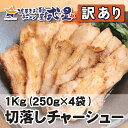
![しずる 煮豚 400g [ 50 g x 8 ] / 厚切り チャーシュー とろとろ / 仕送り、お弁当 、晩酌のおつまみに! バーベキュー 炙りチャーシュー ! らーめん屋さんの本格チャーシュー / お取り寄せグルメ ラーメン 具材 冷凍食品 お惣菜 おかず 送料無料 しずる 煮豚 400g [ 50 g x 8 ] / 厚切り チャーシュー とろとろ / 仕送り、お弁当 、晩酌のおつまみに! バーベキュー 炙りチャーシュー ! らーめん屋さんの本格チャーシュー / お取り寄せグルメ ラーメン 具材 冷凍食品 お惣菜 おかず 送料無料](https://thumbnail.image.rakuten.co.jp/@0_mall/menyasizuru/cabinet/compass1662599039.jpg?_ex=128x128)
